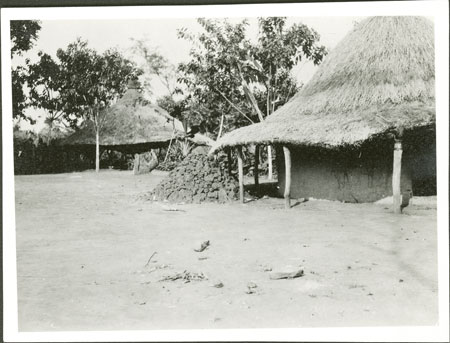Zande grave mound

104 x 78 mm | Print gelatin silver
There are records relating to alternative images that we do not have scans for in the database:
1998.341.133.1 - Negative film nitrate , (104 x 78 mm)
1998.341.133.1 - Negative film nitrate , (104 x 78 mm)
Date of Print:
Unknown
Previous PRM Number:
EP.A.133
Previous Other Number:
47 2 (102) [frame 10]
Accession Number:
1998.341.133.2
Description:
A clay grave mound partly under the eaves of a hut within a compound.
Such mounds (a cultural borrowing of the later 19th century from the Bongo or possibly Amadi) are made soon after burial and are later replaced by a stone mound at a mortuary ceremony of complex rites and observances.
Photographer:
Edward Evan Evans-Pritchard
Date of Photo:
1927 - 1930
Region:
[Southern Sudan] Western Equatoria Yambio
Group:
Zande
PRM Source:
Edward Evan Evans-Pritchard
Acquired:
Donated 1966
Other Owners:
E. E. Evans-Pritchard Collection
Class:
Death , Shelter , Religion
Keyword:
Grave , Building House , Cairn
Documentation:
Original catalogue lists in Manuscript Collections. Additional material in related documents files. [CM 27/9/2005]
Primary Documentation:
PRM Accession Records - [1966.27.21] G PROFESSOR E.
E.
EVANS-PRITCHARD; INST.
OF SOCIAL ANTHROPOLOGY, 51 BANBURY RD.
OXFORD - S.
SUDAN, AZANDE TRIBE.
Box of negatives in envelopes.
Nos.
1 - 400
Added Accession Book Entry - [In pencil in column] Catalogue room.
[1966.27.23] G PROFESSOR E. E. EVANS-PRITCHARD; INST. OF SOCIAL ANTHROPOLOGY, 51 BANBURY RD. OXFORD - S. SUDAN, AZANDE TRIBE. Box of prints in envelopes, nos. 1 - 400 (prints of negatives in 1966.27.21)
Manual Catalogues [typewritten, entitled "Zande Photographs (E-P)"] - 133. Stone grave heap outside hut. (Partly under verandah). 47/2 (102)
Added Accession Book Entry - [In pencil in column] Catalogue room.
[1966.27.23] G PROFESSOR E. E. EVANS-PRITCHARD; INST. OF SOCIAL ANTHROPOLOGY, 51 BANBURY RD. OXFORD - S. SUDAN, AZANDE TRIBE. Box of prints in envelopes, nos. 1 - 400 (prints of negatives in 1966.27.21)
Manual Catalogues [typewritten, entitled "Zande Photographs (E-P)"] - 133. Stone grave heap outside hut. (Partly under verandah). 47/2 (102)
Other Information:
In The Azande (OUP 1971, page 115) E.
E.
Evans-Pritchard notes that 'at present time in the Sudan a corpse is buried under a side niche in a rectangular shaft, and over the grave is erected a low hut with a ridged roof which is eventually replaced at a mortuary ceremony by a high heap of stones.
The construction of this heap forms a central part of a complex of rites and festal observances.' This process is made clearer in more detailed, earlier accounts by Evans-Pritchard, as discussed by Baxter & Butt (London AIA, 1953 page 77).
Here, they make clear that the next day or soon after burial the designated people 'come to erect a tomb over the grave consisting of a ound of clay surmounted by a thatched roof supported on stakes...
The relatives of the deceased have one final and binding obligation, and that is to erect a cairn of stones over the grave' which may take from one to five years after burial, since significant preparations and hospitality need to be organised to accompnay the mortuary ceremony.
The process for an unmarried person, and thus of less social status, is much simpler and probably shorter in duration.
Although Evans-Pritchard describes this image as a 'Stone grave heap', I believe it is more likely to be a clay mound of the type discussed, photographed sometime before its replacement by a stone heap.
It is unclear whether this particular clay heap was ever accompanied by a small shelter of the type described by Evans-Pritchard.
Since part of the heap is under the eaves of a nearby hut such a shelter may never have been constructed.
[Chris Morton 14/10/2003]
Recorder:
Christopher Morton 14/10/2003 [Southern Sudan Project]

